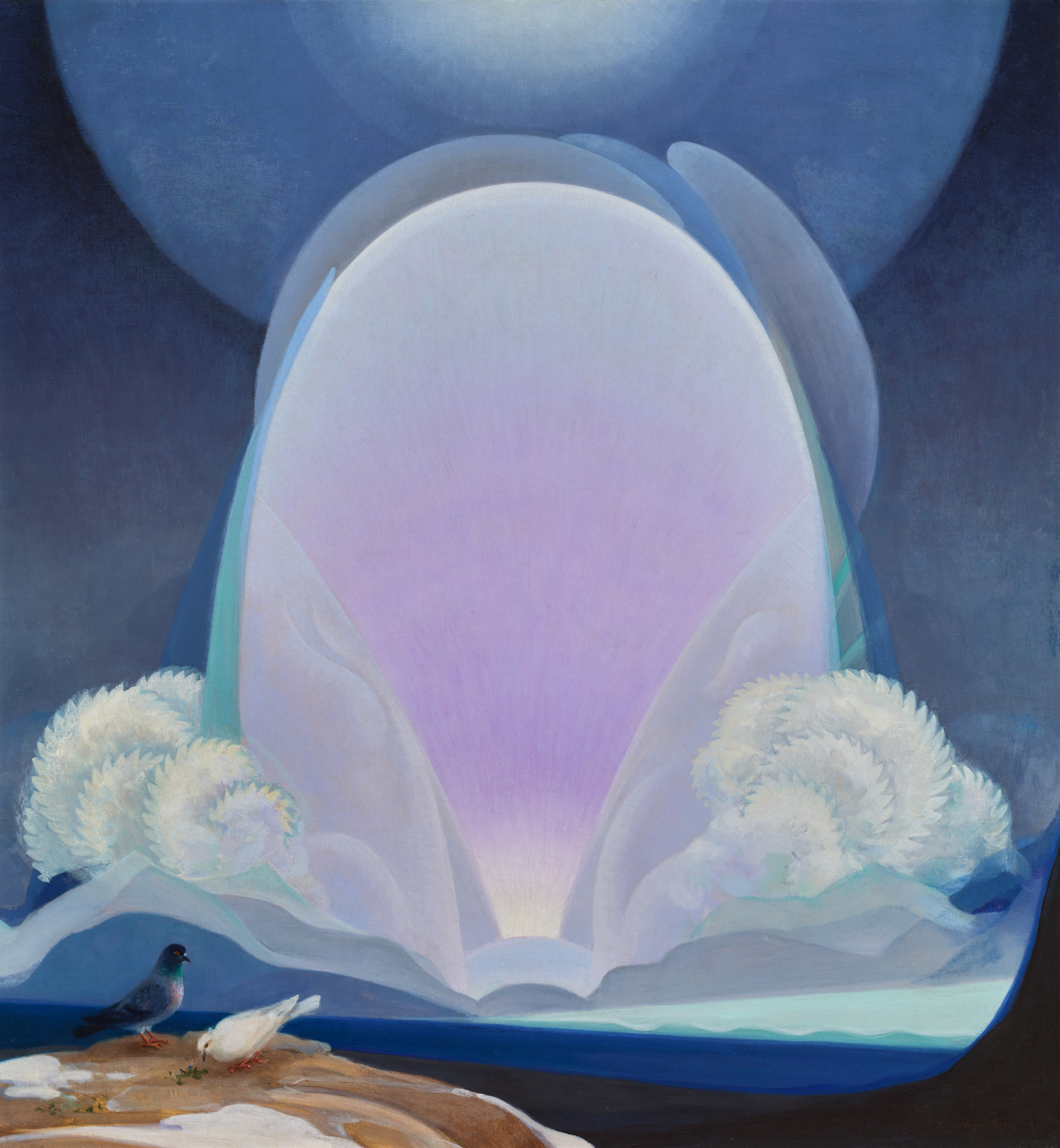O that you would tear open the heavens and come down!
—Isaiah 64:1a
LOOK: Winter by Agnes Pelton

Agnes Pelton was part of the Transcendental Painting Group, an artists’ collective founded in the American Southwest in 1938 on the principles of creating a pure abstract painting style imbued with spiritual intent. Clayton Schuster, writing for Hyperallergic, describes one of Pelton’s metaphysical landscapes:
Pelton’s Winter (1933) depicts a pigeon and dove on a cliff in the foreground, with a great blooming cloud in the distance. The arched lavender cloud against the dark sky seems to suggest the narrow path toward a new beginning, as a pale glow at the top of the painting symbolizes hidden truths. Within the cloud are delicate lines hinting at two hills. The cloud seems to glow where the hills nearly meet and delineate the valley. It is as if Pelton has excavated a road from the cloud and revealed the path to paradise.
Pelton shows us a new way opening. The sky has been rent, and light breaks in. To either side of the central bulbous form are tooth-edged wheels in motion. At the bottom left, the snow is melting at the emerging warmth, revealing tiny green shoots on the ground. The two doves perhaps signify a coming peace.
Full of mystical yearning, this painting shouts “Advent!” to me. It evokes in my mind not only the Isaianic exclamation cited above—the basis for today’s featured song (below)—but several other Advent scriptures as well, such as Isaiah 40:3–5 (pave a straight path for God through the desert; every hill, every valley . . .), Psalm 98:8–9 (“let the hills sing together for joy at the presence of the Lord, for he is coming . . .”), and Revelation 1:7 (“Look! He is coming with the clouds”; cf. Matthew 24:30: “they will see ‘the Son of Man coming on the clouds of heaven’ with power and great glory”).
Pelton was not a Christian—she rejected organized religion—but her artworks are so wonderfully expansive in the associations and interpretations they invite.
For more on the artist, see the wonderful book Agnes Pelton: Desert Transcendentalist, a catalog of a recent major retrospective of her work organized by the Phoenix Art Museum.
LISTEN: “O Savior, Rend the Heavens Wide” (original title: “O Heiland, reiß die Himmel auf”) | Original German words by Friedrich Spee, 1622; translated into English by Martin L. Seltz, 1965, ©1969 Concordia Publishing House | Tune: O HEILAND, REISS DIE HIMMEL AUF, from Gesangbuch, Augsburg, 1666 | Performed by Koiné on Anno Domini, 2009 [sheet music]
O Savior, rend the heavens wide;
Come down, come down with mighty stride;
Unlock the gates, the doors break down;
Unbar the way to heaven’s crown.O Morning Star, O radiant Dawn,
When will we sing your morning song?
Come, Son of God! Without your light
We grope in dread and gloom of night.Sin’s dreadful doom upon us lies;
Grim death looms fierce before our eyes.
O come, lead us with mighty hand
From exile to our promised land.There shall we all our praises bring
And sing to you, our Savior King;
There shall we laud you and adore
Forever and forevermore.
The German hymn text “O Heiland, reiß die Himmel auf” (O Savior, Rend the Heavens Wide) is by Friedrich Spee (1591–1635), a German Jesuit priest, professor, and poet best known for opposing the European witch trials and the use of torture. Written during the Thirty Years’ War, it was first published in Würzburg in 1622 in the collection Das Allerschönste Kind in der Welt (The Most Beautiful Child in the World).
Four-plus decades later, in 1666, a Dorian-mode melody was published anonymously with the text in the Rheinfelsisches Deutsches Katholisches Gesangbuch (German Catholic Hymnal). Then in 1863, Johannes Brahms arranged that melody as a motet for unaccompanied mixed choir (op. 74, no. 2):
The hymn entered English-speaking churches in the twentieth century when Martin L. Seltz (1909–1967) translated it.
The original chorale tune is still in use, but I’ve also heard some churches using the 2003 retune by Nathan Partain. Here’s a live recording of that version from Trinity Church Seattle, sung by Partain, back when he was the church’s music director (it was called Green Lake Presbyterian Church at the time):
The hymn also appears, with updated arrangement, on Partain’s 2019 album The Beauty to Come. The chord charts, lead sheets, and string scores for this album and two others can be downloaded for free from Partain’s website.
This post is part of a daily Advent series from December 2 to 24, 2023 (with Christmas to follow through January 6, 2024). View all the posts here, and the accompanying Spotify playlist here.

This is a wonderful opening to Advent! Thank you. We had the Another World exhibit here at the ABQ Museum a couple years back with this very painting. That’s when I was introduced to the luminosity of Pelton’s work. I’m glad you made this connection with Isaiah 64.Blessings, Libbie Weber+
LikeLike
[…] Art & Theology have a daily offering, starting here […]
LikeLike